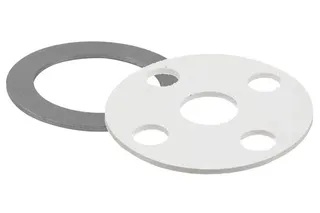PTFE vs. Graphite Gaskets: Choosing the Right Sealing Solution for Your Industry
In today’s industrial landscape, sealing components are far more than simple accessories—they are essential for keeping systems safe, efficient, and leak-free. Across industries like oil and gas, chemicals, pharmaceuticals, power generation, and machinery manufacturing, high-quality gaskets help maintain pressure, prevent leaks, and reduce environmental risks. Among the many materials available, PTFE and graphite gaskets are two of the most widely used. Each has distinct advantages, and understanding their properties can help you choose the right gasket for your application.
PTFE Gaskets: Chemical Resistance Meets Clean Performance
PTFE (Polytetrafluoroethylene), commonly known as Teflon, is a high-performance plastic used to produce gaskets by machining or cutting sheets, rods, or tubes. Precision in manufacturing ensures tight, reliable sealing. Key features of PTFE gaskets include:
1. Exceptional Chemical Resistance
PTFE resists almost all chemicals, from strong acids and bases to solvents and water. This makes it ideal for chemical plants, pharmaceutical factories, and other environments with aggressive fluids.
2. Stable Performance Across Temperature Ranges
PTFE maintains elasticity and toughness in temperatures from -196°C to +250°C. It adapts to thermal expansion, vibration, or fluctuating pressures, making it suitable for piping systems, pumps, valves, and heat exchangers.
3. Non-Stick Surface
Its low surface energy prevents adhesion, making PTFE gaskets easy to clean and replace. This property is particularly valuable in food processing, pharmaceuticals, and other hygienic applications.
4. Reliable Sealing
PTFE gaskets can be customized for density and hardness, offering elasticity and compression recovery. They provide self-tightening, multi-layered sealing that withstands pressure and temperature variations.
5. Broad Compatibility
From water and oil to acids and alkalis, PTFE is chemically inert, non-toxic, and biologically safe, making it suitable even for medical and food applications.
Key Quality Considerations:
- Thickness Tolerance: Prevents deformation under sustained pressure.
- Material Purity: Pure PTFE or dispersion-resin PTFE ensures superior performance.
- Manufacturing Process: Precision machining improves dimensional accuracy and reliability.
Graphite Gaskets: Strength and Heat Resistance in Tough Conditions
Graphite gaskets are produced from high-carbon natural flake graphite, processed to enhance flexibility, resilience, and thermal resistance. Commonly cut or punched into shape, these gaskets are highly effective in extreme environments.
1. High-Temperature Resistance
Graphite can withstand temperatures up to 1000°C (depending on reinforcement), making it ideal for power plants, steel manufacturing, and petrochemical applications.
2. Strong Chemical Resistance
Graphite is compatible with most acids, alkalis, and organic solvents, providing reliable sealing in chemically aggressive environments.
3. Flexibility and Compressibility
Graphite conforms to uneven surfaces, compensating for minor flange damage or warping while maintaining a secure seal.
4. Thermal Conductivity
Unlike PTFE, graphite conducts heat efficiently, reducing hotspots and thermal stress in high-temperature systems.
5. Cost-Effective and Accessible
Graphite gaskets are relatively inexpensive and easy to produce, making them a practical choice for many industrial applications.
Key Quality Considerations:
- Raw Material: High-carbon, flake graphite performs best.
- Reinforcement: Stainless steel mesh or foil improves strength and pressure resistance.
- Dimensional Accuracy: Well-cut gaskets ensure better sealing and longer service life.
Choosing the Right Gasket
Selecting between PTFE and graphite depends on your specific operating conditions:
- High Temperatures: Graphite is ideal for systems with sustained or fluctuating heat.
- Aggressive Chemicals: PTFE excels with highly corrosive or ultra-pure fluids.
- Ultra-Clean Environments: PTFE is preferred for food, pharmaceutical, and medical applications.
- High Pressure & Heat: Reinforced graphite handles extreme combinations of temperature and pressure.
- Maintenance: PTFE’s low-friction surface allows easier removal and replacement.
- Cost Efficiency: Graphite provides reliable performance at a lower cost.
Conclusion
Both PTFE and graphite gaskets are reliable solutions for industrial sealing. PTFE offers chemical resistance, flexibility, and cleanliness, while graphite provides heat resistance, strength, and cost-effectiveness. By carefully assessing your application’s temperature, pressure, chemical exposure, hygiene requirements, and budget, you can select a gasket that ensures optimal performance and longevity.
Choosing the right gasket is more than a technical decision—it’s key to operational safety, efficiency, and maintenance efficiency in any industrial system. It's important to know about Google SEO to help your website rank higher in search results.





Comments